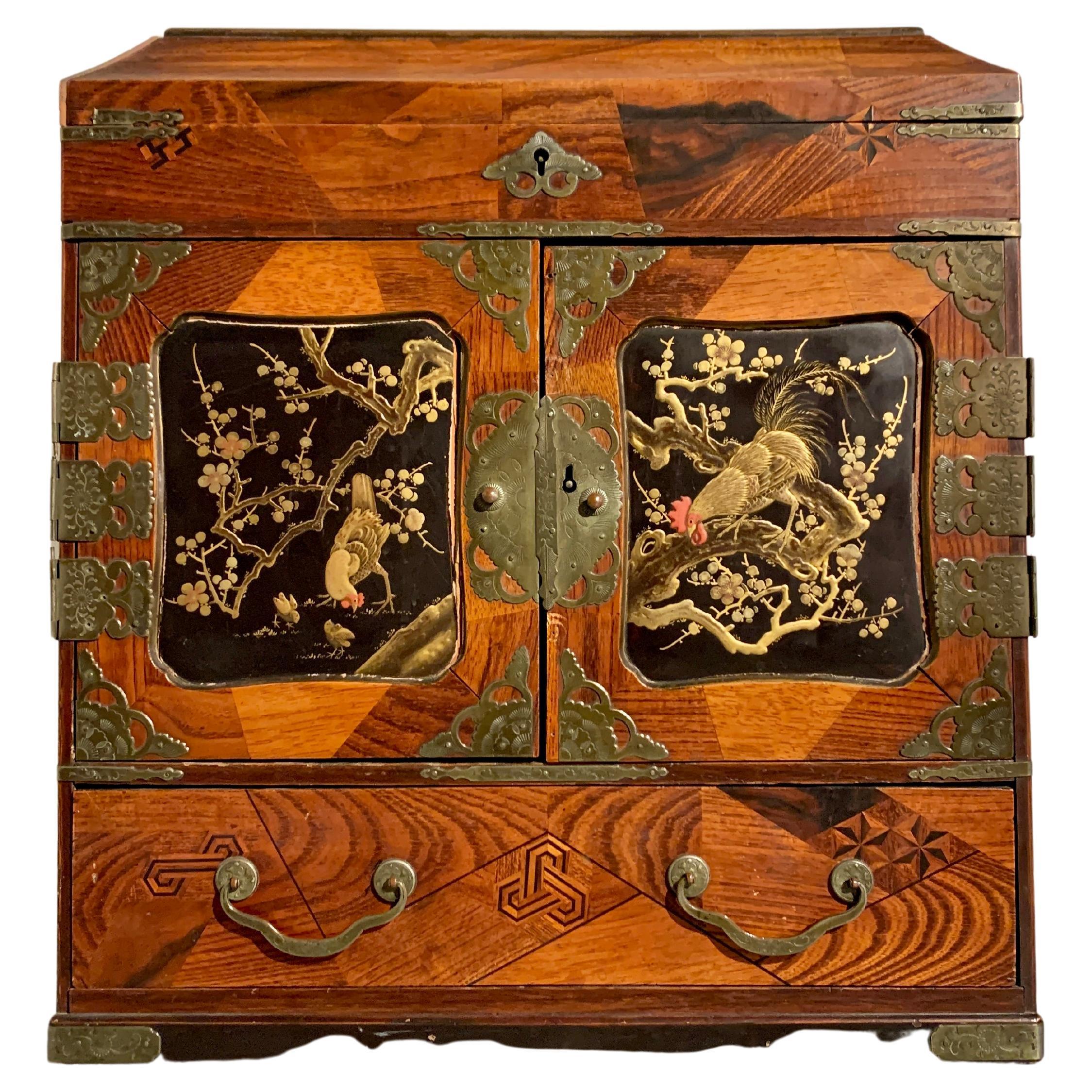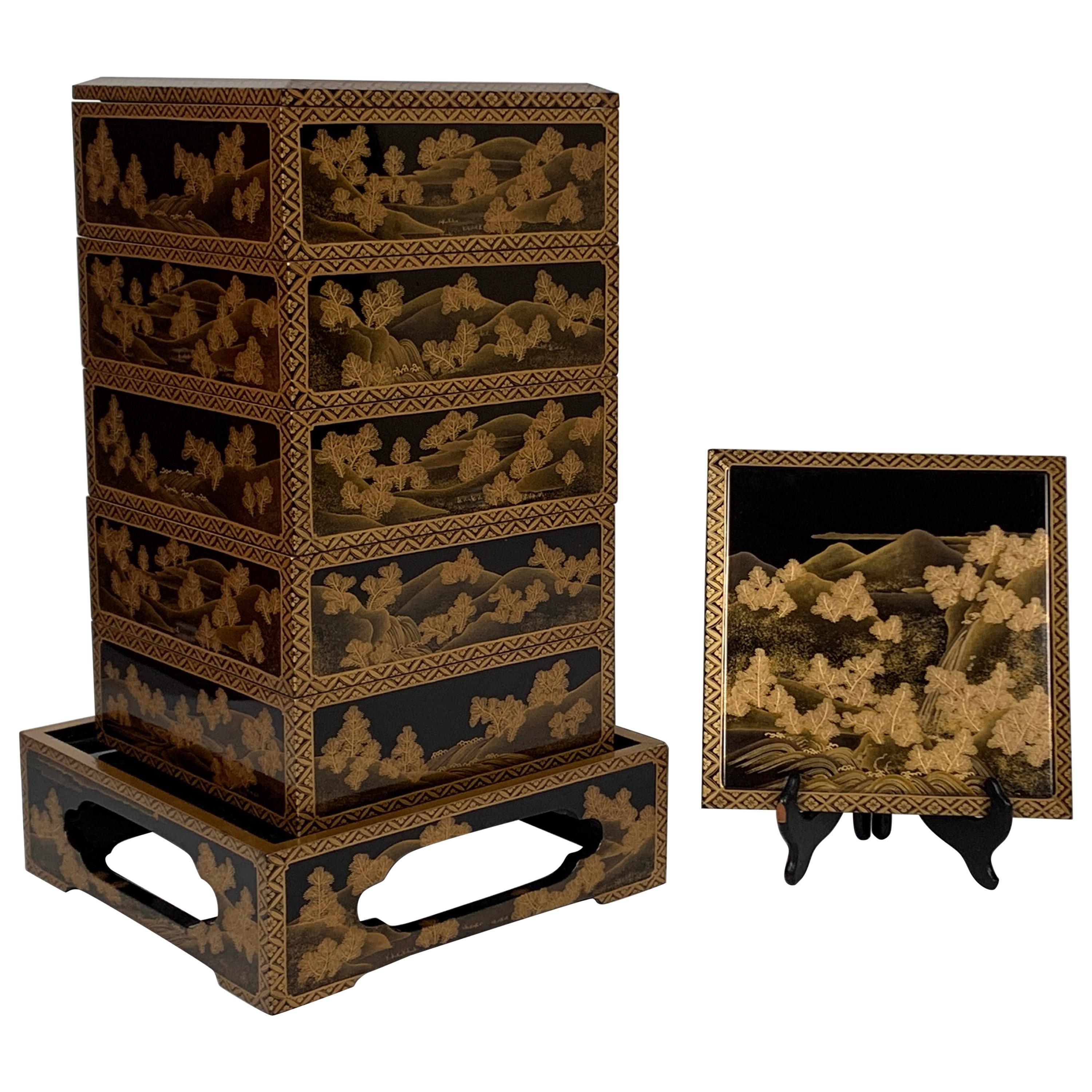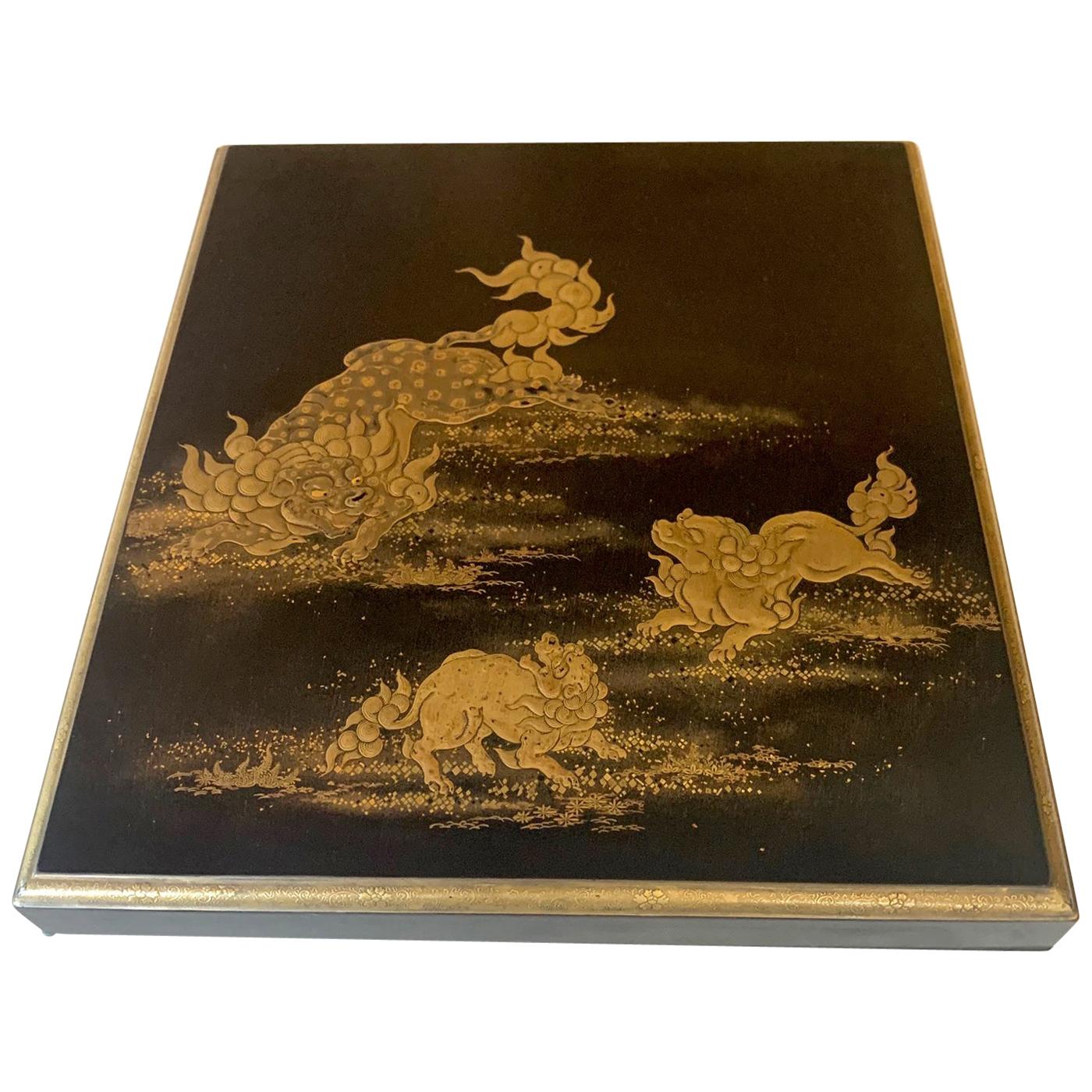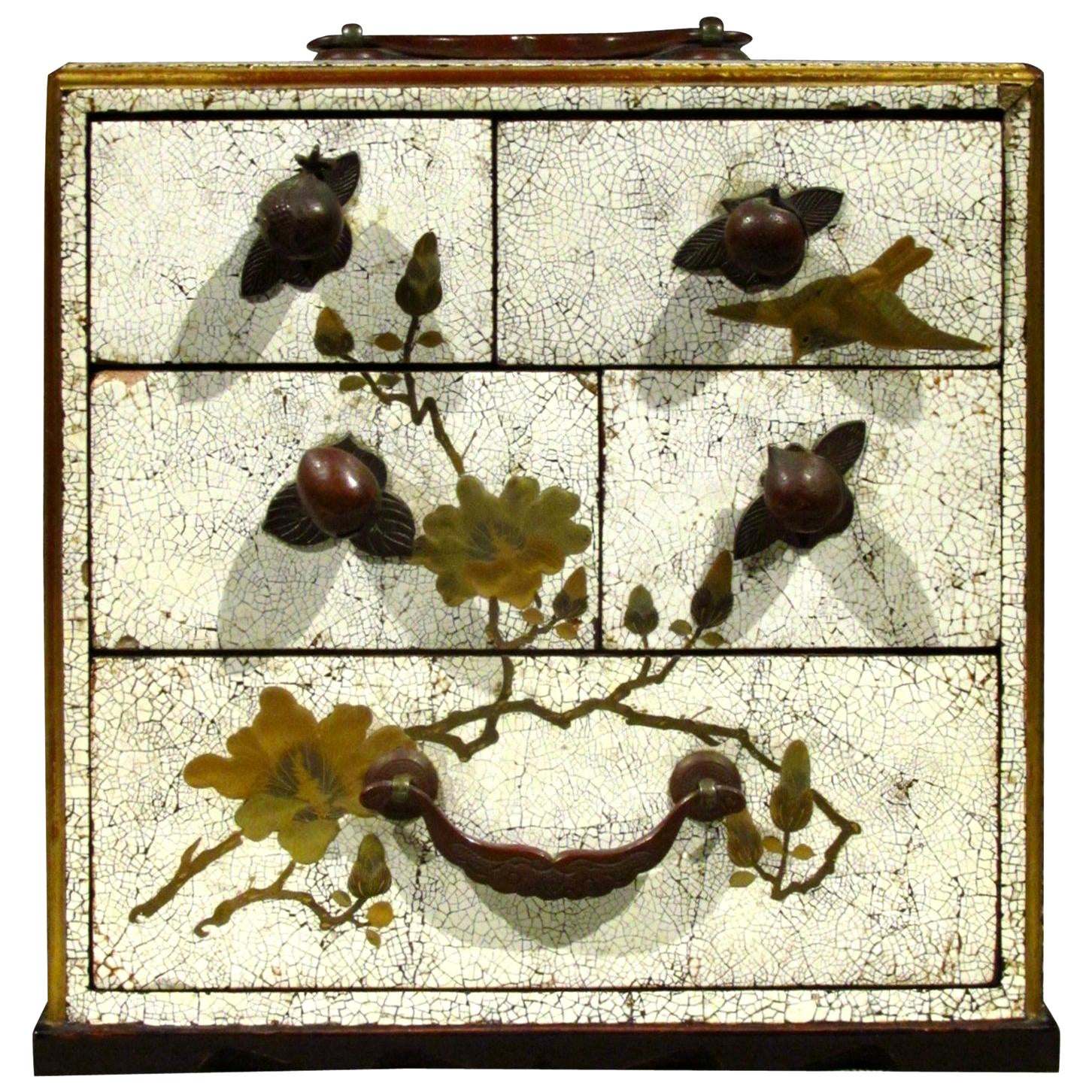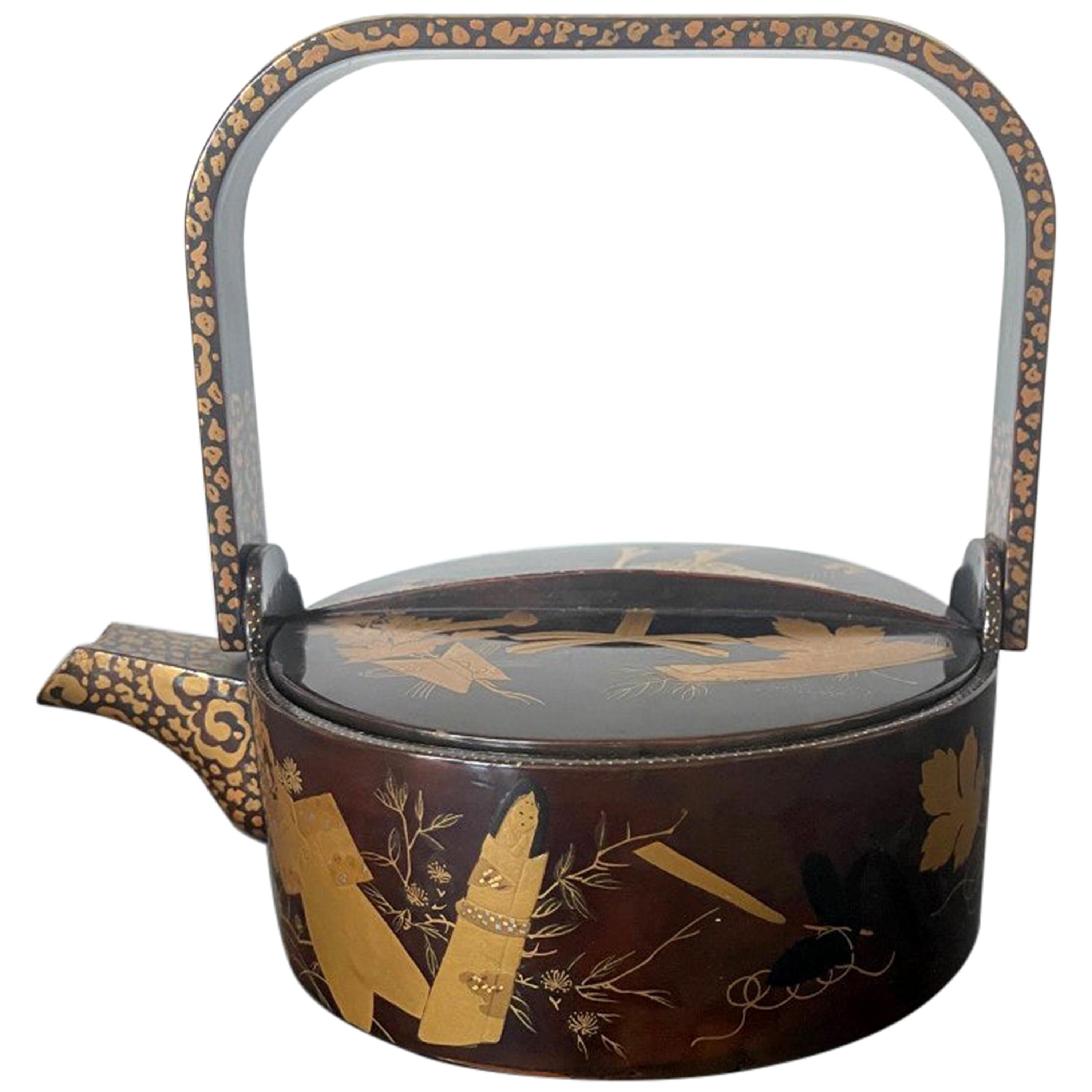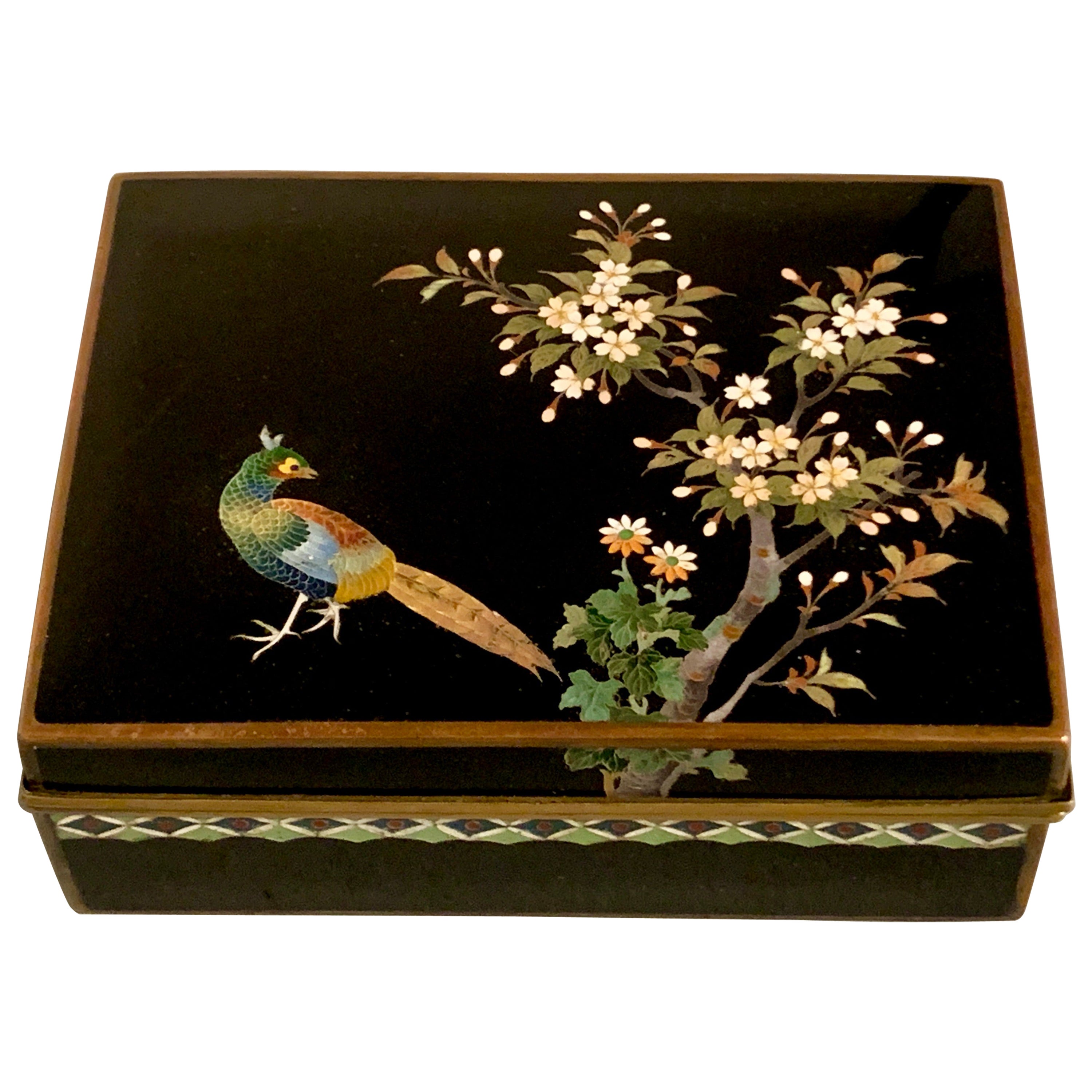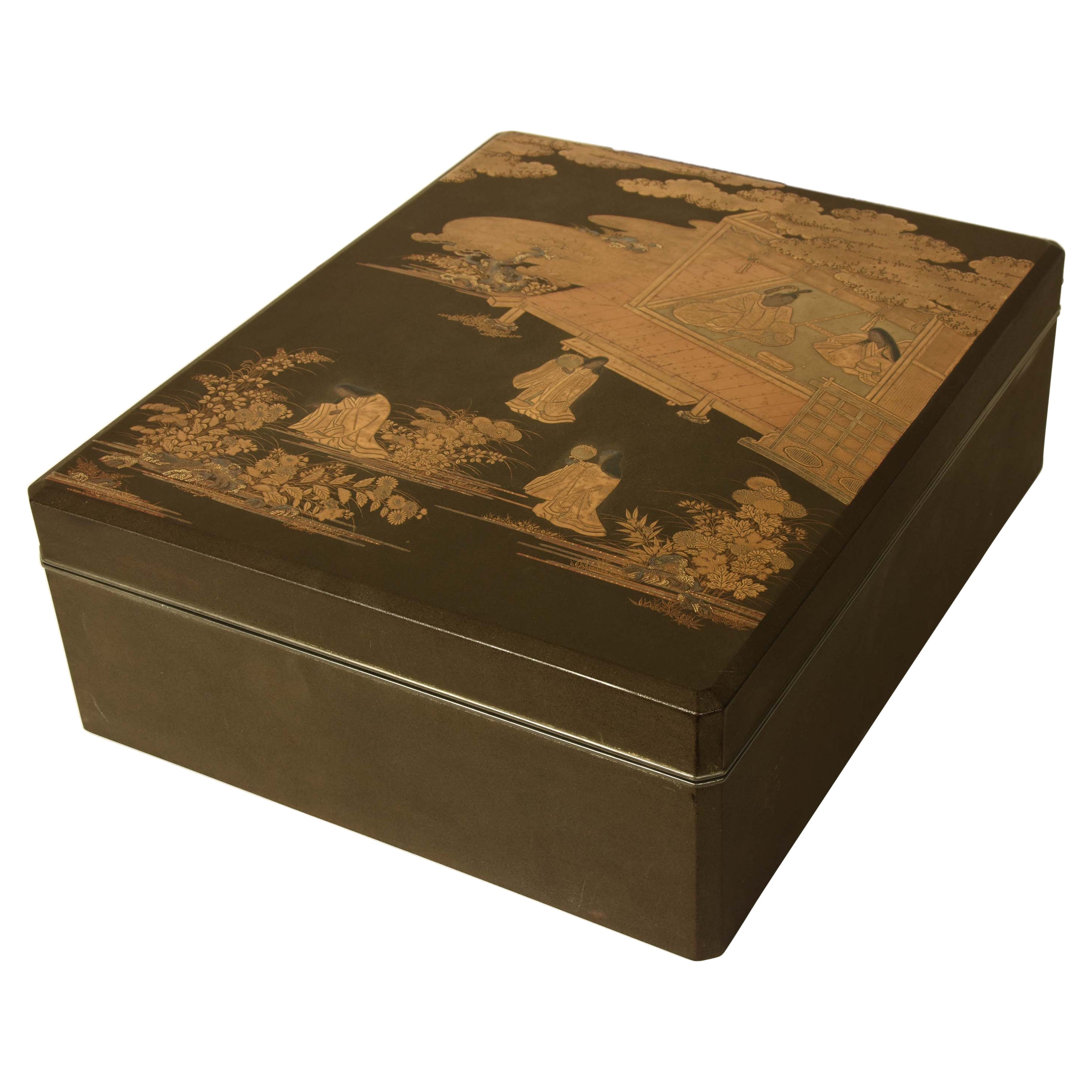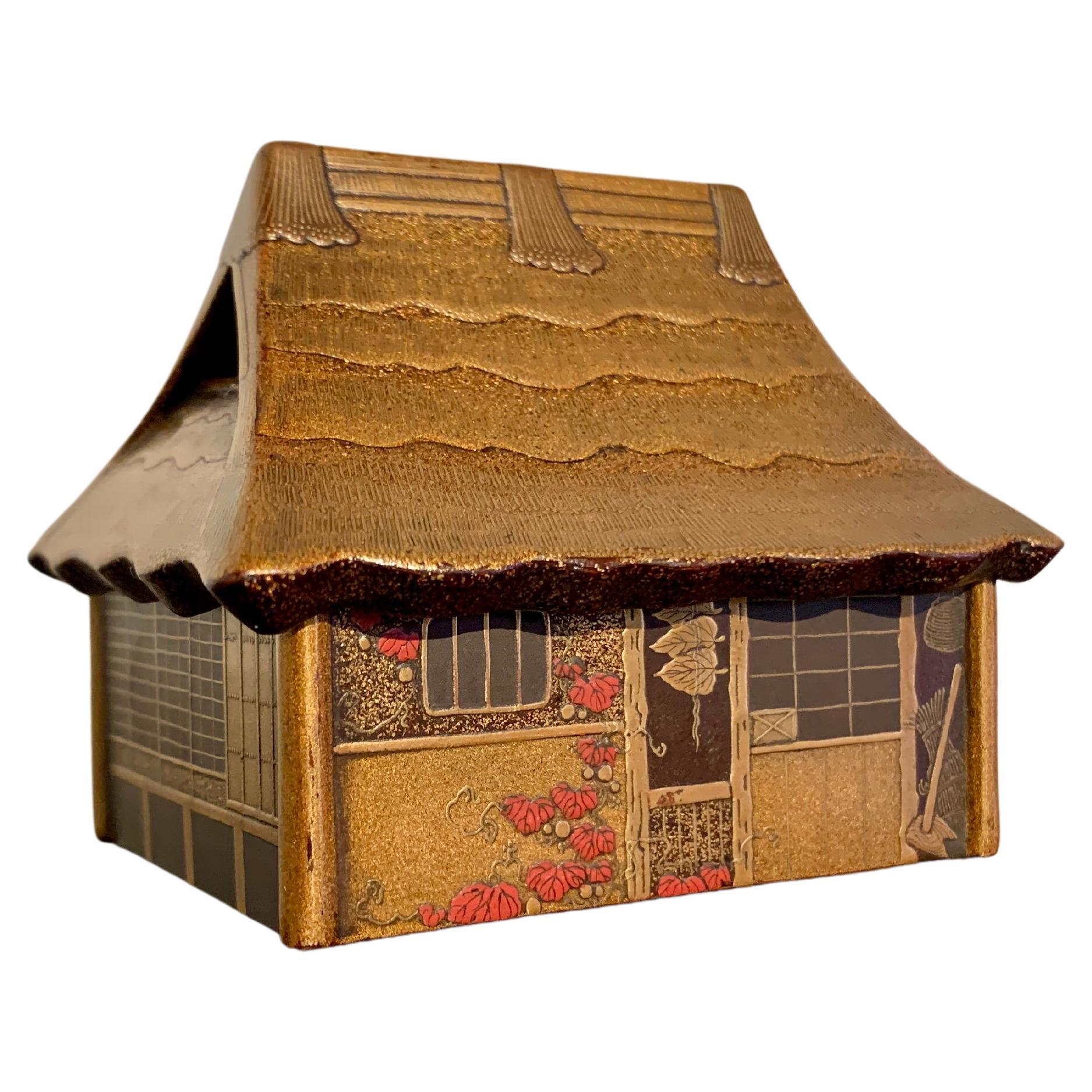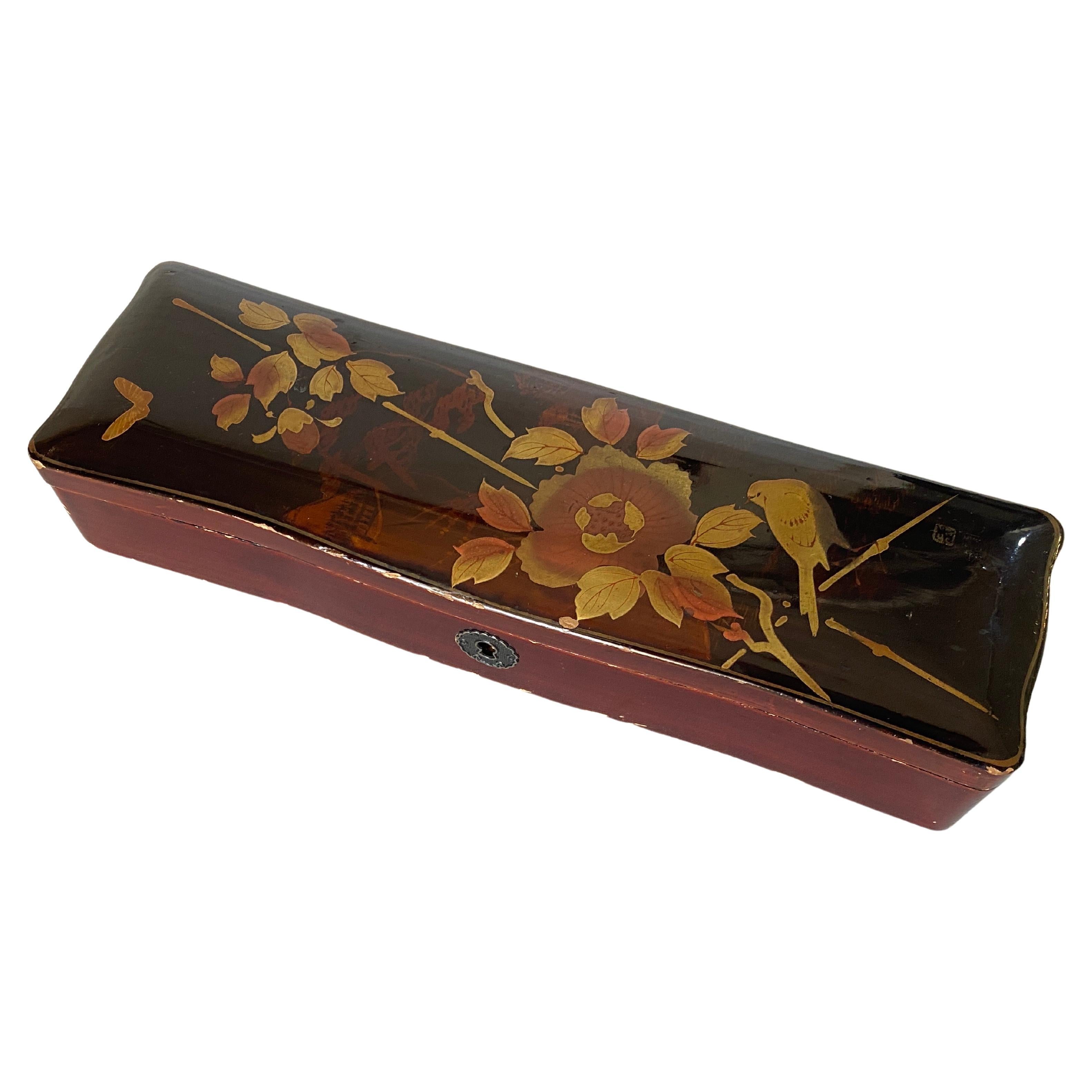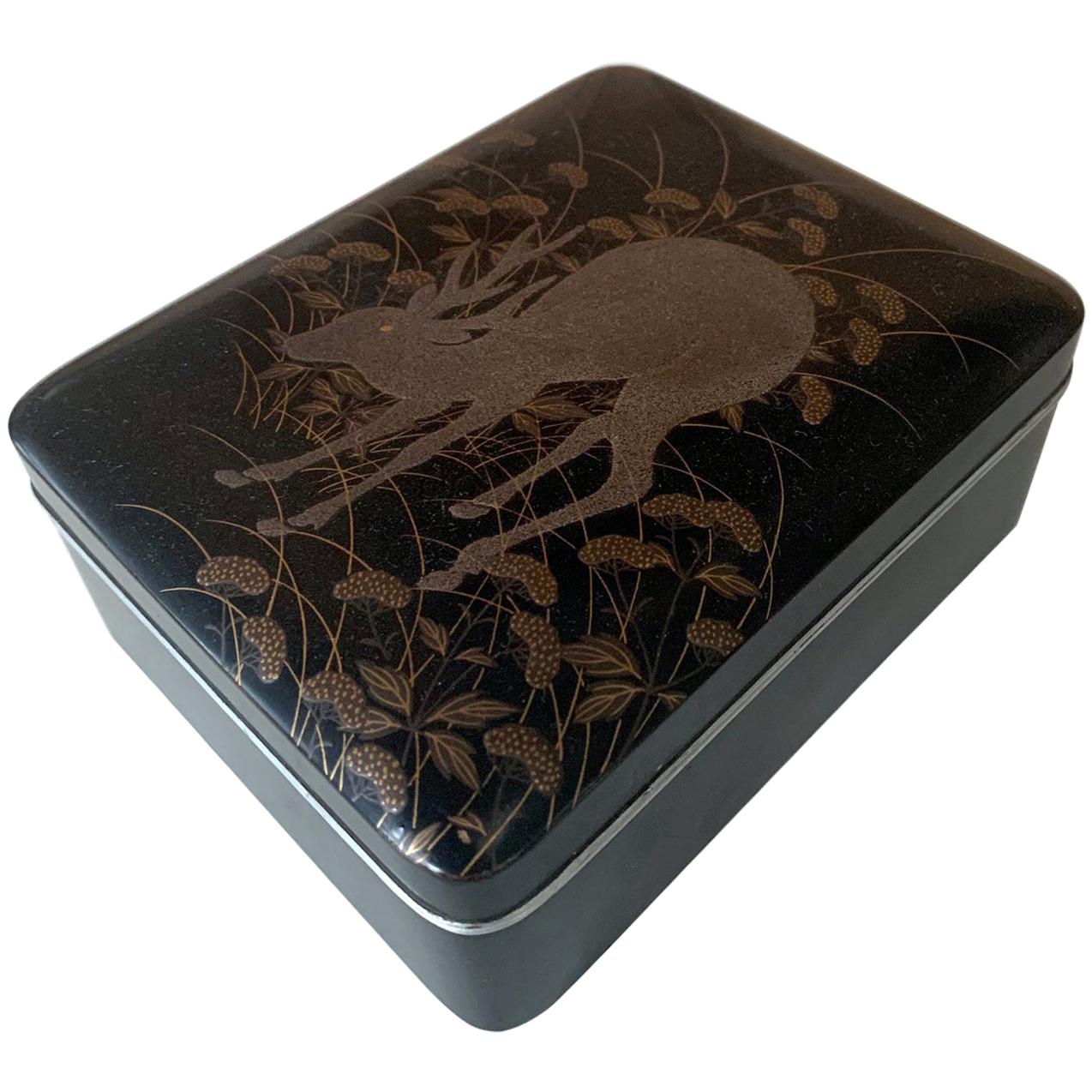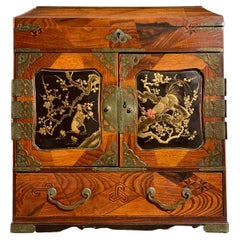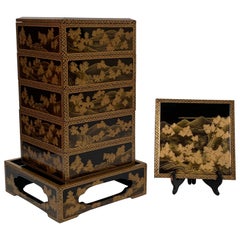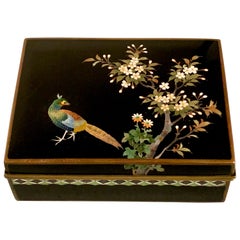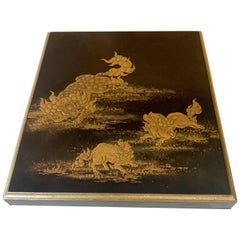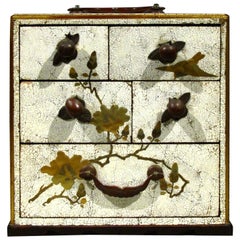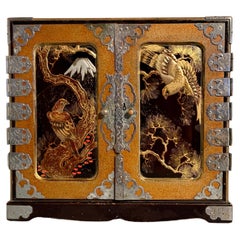
Japanese Maki-e Lacquer Jewelry Box Chest, Meiji Period, circa 1900, Japan
View Similar Items
Want more images or videos?
Request additional images or videos from the seller
1 of 13
Japanese Maki-e Lacquer Jewelry Box Chest, Meiji Period, circa 1900, Japan
About the Item
- Dimensions:Height: 8.5 in (21.59 cm)Width: 9.5 in (24.13 cm)Depth: 5.25 in (13.34 cm)
- Style:Meiji (Of the Period)
- Materials and Techniques:
- Place of Origin:
- Period:1900-1909
- Date of Manufacture:circa 1900
- Condition:Repaired: Evidence of minor glue repair to the left back edge. Wear consistent with age and use. Minor losses. Minor fading. With small nicks and gouges to the lacquer, especially the top of the cabinet, as seen in photos. The interior of the doors with some separation following the inset panels - see photos. Missing the key.
- Seller Location:Austin, TX
- Reference Number:1stDibs: LU894734848622
About the Seller
5.0
Gold Seller
These expertly vetted sellers are highly rated and consistently exceed customer expectations.
Established in 2001
1stDibs seller since 2010
305 sales on 1stDibs
Typical response time: 1 hour
More From This SellerView All
- Japanese Marquetry and Lacquer Jewelry Chest, Meiji Period, circa 1900, JapanLocated in Austin, TXA very attractive Japanese wood table top jewelry or collector's chest with marquetry and lacquer decoration, Meiji period, circa 1900, Japan. Previously in the collection of Asbjorn Lunde (1927 - 2017). The chest is crafted in the form of a Chinese seal...Category
Antique Early 1900s Japanese Meiji Lacquer
MaterialsWood, Softwood, Lacquer
- Japanese Maki-e Lacquer Stacking Box, Jubako, Meiji Period, JapanLocated in Austin, TXA fine and impressive Japanese gold maki-e decorated black lacquer five-tier jubako with presentation tray, two lids, and the original tomobako storage box, Meiji period, late 19th c...Category
Antique Late 19th Century Japanese Meiji Lacquer
MaterialsLacquer
- Japanese Cloisonne Box by Inaba, Meiji Period, circa 1900, JapanBy Inaba Cloisonne Co.Located in Austin, TXA fine Japanese cloisonne hinged box with pheasant and autumn foliage, by Inaba Nanaho and the Inaba Cloisonne Company, Meiji period, circa 1900, Japan. The lovely jewelry or trin...Category
Antique Early 1900s Japanese Meiji Metalwork
MaterialsCopper, Enamel, Metal
- Japanese Lacquer House Shaped Incense Box, Kogo, Meiji Period, JapanLocated in Austin, TXA delightful and intricately decorated lacquer box for storing incense, kogo, in the form of a traditional farm house, Meiji period (1864 - 1912), late 19th century, Japan. The kogo, or small box for storing incense, takes the whimsical form of a traditional Japanese home, minka, with the removable high, thatched roof serving as the cover for the box. The exterior of the home has been painstakingly decorated in maki-e lacquer against a matte black lacquer ground. Traditional shoji doors, bamboo blinds...Category
Antique Late 19th Century Japanese Meiji Lacquer
MaterialsLacquer
- Japanese Cloisonne Box, Meiji Period, Late 19th Century, JapanLocated in Austin, TXA very fine and intricately decorated Japanese cloisonné box and cover, Meiji period, late 19th century, Japan. The lidded trinket or jewelry...Category
Antique 1890s Japanese Meiji Metalwork
MaterialsBrass, Copper, Enamel
- Small Japanese Lacquer Duck Incense Box, Kogo, Meiji Period, Late 19th CenturyLocated in Austin, TXAn exquisite Japanese Meiji Period small lacquer incense box, kogo, in the form of a duck or goose, late 19th century, Japan. The delicate lacquer box, known as a kogo in Japanese, ...Category
Antique Late 19th Century Japanese Meiji Lacquer
MaterialsLacquer
You May Also Like
- Japanese Meiji Period Antique Lacquer Box with Gold Maki-e DecorationLocated in New York, NYA fine antique Japanese Meji Period lacquer box decorated with a fan and a stylized star shaped window in the maki-e technique. The fan at the top right corner, fully opened depictin...Category
Antique 19th Century Japanese Meiji Lacquer
MaterialsLacquer
- Japanese Lacquer Box with Fine Maki-e Decoration Meiji PeriodLocated in Atlanta, GAA lacquered wood box with lid from Japan circa 19th century Meiji Period. The finely decorated box was used to store paper slips and small documents on the desk. It is overall finished with black lacquer (kuro) with sparse Mura-Nashiji effect outside and on the top surface of the lid, there are three Komainu, (sometimes known as Shishi or Japanese lions) frolicking and forming a circle in lively motion. Komainu are auspicious animals in Japanese cultures in both Shinto and Buddhism tradition. Originally from China, these animals symbolizes guardians to ward off evil spirits. Hiramaki-e was used in combination with carving and combing to render the lions with various surface textures. A gilt border with an slight angle was given to the lid and even the thin band is decorated with miniature floral scrolls. The interior of the box was finished in a dense nashiji. Underneath the lid, a cluster of peonies open lavishly by two gentle mounts. Takamaki-e (high relief) in both gold and silver were...Category
Antique Late 19th Century Japanese Japonisme Lacquer
MaterialsWood, Lacquer
- Signed Japanese White Lacquer and Maki-E Lacquer Tansu, Meiji PeriodLocated in Ottawa, OntarioThe case decorated overall in crackle-glaze white lacquer and fitted with a patinated metal carrying handle over three tiers of small drawers. The first two tiers are comprised of a ...Category
Antique Late 19th Century Japanese Meiji Lacquer
MaterialsLacquer
- Japanese Lacquer Maki-e Sake Ewer Meiji PeriodLocated in Atlanta, GAA Japanese lacquered wood sake ewer with maki-e design, circa late 19th century, Meiji period. The nicely decorated lacquerware is of a Classic sake ewer for...Category
Antique 1890s Japanese Japonisme Lacquer
MaterialsLacquer
- Japanese Black Lacquer Document Box with Gold Maki e Design, Meiji PeriodLocated in Prahran, VictoriaAn antique black lacquer document box with an exquisitely detailed, finely wrought design from The Tale of the Genji depicted in gold maki e across the lid. Internally, the box is de...Category
Early 20th Century Japanese Lacquer
MaterialsWood, Lacquer
$5,200 Sale Price20% Off - Meiji Period Lacquer BoxLocated in Chapel Hill, NCMeiji period small lacquer box with hinged lid, Japanese. Finely decorated - bits of abalone inlay add sparks in several areas. The recessed circle...Category
Antique Late 19th Century Japanese Meiji Decorative Boxes
MaterialsLacquer
Recently Viewed
View AllMore Ways To Browse
Antique Needle Cabinet
Meiji Hawk
Seven Samurai
George Nelson Jewelry Box
Herend Trinket
Medieval Bronze Jewelry Caskets
Victorian Necessaire De Voyage
Agresti Pen Box
Wavy Mirror Velvet
Antique Wavecrest
Capiz Shell Box
Fred Buss
Vintage Birks Ring Box
Vintage Birks Sterling Silver Ring Box
Bvlgari Roma Logo
Cartier Vendome Santos Sunglasses Large
Jewerly Box
Pink Casket Box
